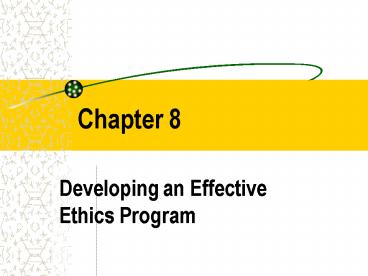Developing an Effective Ethics Program - PowerPoint PPT Presentation
1 / 13
Title: Developing an Effective Ethics Program
1
Chapter 8
- Developing an Effective Ethics Program
2
The Need for Organizational Ethics Programs
- Scandals in corporate America have lowered the
publics trust of business. - Employees are not legal experts and therefore
need guidance with legal issues impacting
their jobs. - Helps ensure that all employees understand the
organizations values and comply with the
policies and codes of conduct that create its
ethical climate
3
Ethics Programs Can Help Avoid Legal Problems
- The Federal Sentencing Guidelines for
Organizations encourage companies to assess their
key risks and customize a program to address
these risks. - The program must be communicated to all
employeesproviding a common understanding of
organizational values, policies, and procedures. - Companies that act to prevent organizational
misconduct may receive a carrot and avoid
organizational penalties. - Those that do not may receive a stick
fines and penalties.
4
The Sentencing of Organizations Under the
FSGO Is Governed by Four Considerations
- The organization must remedy the harm.
- Fines may be set sufficiently high to divest the
organization of all assets if it is found to have
operated with criminal purpose. - Fines are based on the seriousness of the offense
and the culpability of the organization. - Probation is deemed appropriate when the
organization will work to prevent further
misconduct.
5
Values Versus Compliance Programs
- compliance orientation
- creates order by requiring that employees
identify with and commit to specified conduct - uses legal terms, statutes and contracts that
teach employees the rules and penalties for
noncompliance - values orientation
- attempts to develop shared values
- focuses more on an abstract core of ideals such
as respect and responsibility, although there are
penalties for misconduct
6
Codes of Conduct...
- are formal statements of what an organization
expects in the way of ethical behavior - will not solve every dilemma
- provide rules and guidelines
- reflect senior managements desire for compliance
with values, rules and policies in support of an
ethical climate - should be specific enough to be reasonably
capable of preventing misconduct
7
Codes of Conduct...
- codes of conduct
- formal statements that describe what an
organization expects of its employees - codes of ethics
- most comprehensive document consisting of general
statements that serve as principles and the basis
for the rules of conduct - statement of values
- serves the general public and addresses
stakeholder interests
8
Manleys Six Steps to Implementing a Code of
Ethics
- distribute the code comprehensively employees,
subsidiaries, and associated companies - assist in interpretation and understanding
- specify managements role in implementation
- make employees responsible for understanding
- establish grievance procedures
- provide a conclusion or closing statement
9
Ethics Officers
- Ethics officers or committees are responsible for
oversight of the ethics/compliance program - coordinate program with top management
- develop, revise and disseminate the code
- develop effective communication
- establish audits and control systems
- provide consistent enforcement of standards
- review and modify the program to improve
effectiveness
10
Ethics Training and Communication
- provides guidance for ethical standards and
activities that integrate the functional areas of
business - helps employees identify ethical issues and
provides a means to address and resolve them - can help reduce criminal, civil, and
administrative consequences
including - fines, penalties, judgments, etc.
11
Systems to Monitor and Enforce Ethical
Standards
- An internal system for employees to report
misconduct is an opportunity to register ethical
concerns - ethics hot lines
- questionnaires used to serve as benchmarks
- Enforcement is also important
- corrective actions to provide standards
and punishment - consistent enforcement critical
12
Continuous Improvement of the Ethics Program
- If a company has determined that its ethical
performance has not been satisfactory, management
may want to recognize the way ethical decisions
are made - A decentralized organization may be centralized
(perhaps temporarily) so that top-level managers
can ensure that ethical decisions are made. - A centralized organization may be decentralized
(perhaps temporarily) so that lower level
managers can make more decisions.
13
Common Mistakes in Designing/ Implementing an
Ethics Program
- not having a clear understanding of the goals of
the program from the beginning - not setting realistic and measurable program
objectives - senior managements failure to take ownership of
the ethics program - developing program materials that do
not address the needs of the
average employee - transferring a domestic program internationally
- designing a program as a series of lectures






























